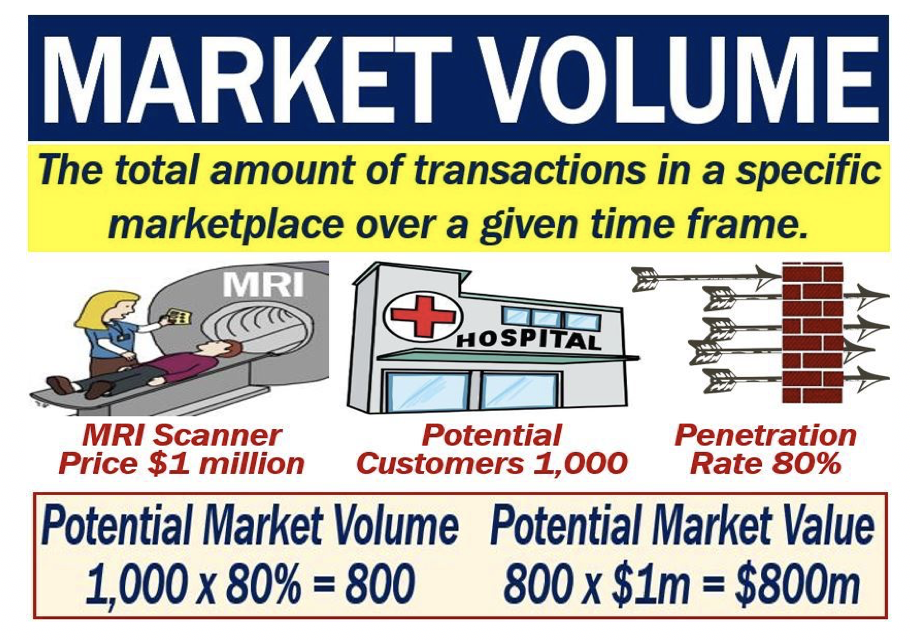Market volume refers to the total amount of transactions that traders conducted in a specific market. We calculate the total volume of transactions over a specific period such as a day, month, quarter, or year. The count of total volume comprises each transaction between sellers and buyers, i.e., traders.
In the world of stock exchanges, the stock market volume is the total number of shares that people traded each day. We also call this the ‘trading volume.’
Stock markets are places where people buy and sell company shares. The New York Stock Exchange and the London Stock Exchange, for example, are famous stock markets.
Given that for each purchaser there is a seller, trading volume in a stock market, for example, equals half the number of shares transacted. In other words, if John sells 1,000 shares to Mary, and Mary purchases 1,000 shares from John, market volume is 1,000.

Market volume – sources
We can obtain data regarding market volumes from primary as well as secondary sources.
Organized exchanges and markets, for example, are primary sources. Secondary sources, on the other hand, include research organizations, retailers, and surveys.
Market volume and penetration rate
Penetration rate refers to the percentage of the relevant population in a study that has bought a brand at least once. Studies always look at penetration rates over a specific period such as a day, quarter, etc.
If we multiply our number of target customers by the penetration rate, we get the overall market potential. In this context, market potential means the potential market volume.
Let’s look at a fictitious example. XYZ Inc. has 1,500 target customers for AAA. AAA is its new product. Let’s suppose AAA’s penetration rate is 65%. We calculate the potential volume as follows:
1,500 x 65% = 975
Market volume vs. market value
As soon as we know what the volume of the market is, calculating its monetary value is easy.
We calculate market value by multiplying market volume by the price of each unit.
Let’s assume that each unit of AAA sells for $1 million. To calculate the monetary market value, we make the following calculation:
975 buyers x $1 million = $975 million
Compound phrases
We can make many 3-word compound phrases from the term ‘Market Volume.’ Here are 15 of them:
-
Annual Market Volume
Refers to the total amount of trade in a market over the course of a year.
-
Global Market Volume
The aggregate volume of trade in markets worldwide.
-
Regional Market Volume
The total trade volume within a specific geographic region.
-
Projected Market Volume
An estimate of future trade volume in a market.
-
Daily Market Volume
The total volume traded in a market during a single day.
-
Retail Market Volume
The amount of goods traded within the retail sector.
-
Wholesale Market Volume
Volume of goods traded in bulk between businesses, rather than directly to consumers.
-
Stock Market Volume
The number of shares traded in the stock market within a specific timeframe.
-
Commodity Market Volume
The total amount of a specific commodity traded in the market.
-
Foreign Market Volume
The volume of trade in markets outside the domestic or local market.
-
Cryptocurrency Market Volume
The trading volume of cryptocurrencies across various exchanges.
-
Fixed-Income Market Volume
The total trade volume of debt instruments like bonds.
-
Derivative Market Volume
The amount of trade in derivative instruments such as futures and options.
-
Electronic Market Volume
The trade volume executed through electronic trading platforms.
-
Historical Market Volume
Data on past market trade volumes, used for analysis and comparison.
Other languages
Here is the term ‘Market Volume’ in some other languages:
- Spanish: Volumen de Mercado
- Hindi: बाज़ार की मात्रा (Bazaar ki Maatra)
- French: Volume du Marché
- Arabic: حجم السوق (Hajm as-suq)
- Bengali: বাজারের আয়তন (Bajarer Ayoton)
- Russian: Объём Рынка (Obyom Rynka)
- Portuguese: Volume de Mercado
- Indonesian: Volume Pasar
- Urdu: مارکیٹ کا حجم (Market ka Hajm)
- German: Marktvolumen
- Japanese: 市場のボリューム (Ichiba no boryūmu)
- Swahili: Kiasi cha Soko
- Marathi: बाजाराची आवक (Bazaarachi Aavak)
- Telugu: మార్కెట్ వాల్యూమ్ (Market Volume)
- Turkish: Piyasa Hacmi
- Korean: 시장 규모 (Sijang gyumo)
- Tamil: சந்தை அளவு (Sandhai Alavu)
- Vietnamese: Khối Lượng Thị Trường
- Italian: Volume di Mercato
- Gujarati: બજારની માત્રા (Bajar ni Matra)
- Farsi: حجم بازار (Hajm-e Bazaar)
- Bhojpuri: बाजार के आयतन (Bazaar ke Ayatan)
- Hakka: 市場量 (Shìchǎng liàng)
- Mandarin Chinese: 市场量 (Shìchǎng liàng)
- Cantonese Chinese: 市場量 (Si5 cheung4 leung4)
- Jin Chinese: 市场量 (Shìchǎng liàng)
- Southern Min: 市場量 (Chhī-tiûⁿ liōng)
- Kannada: ಮಾರುಕಟ್ಟೆ ಪರಿಮಾಣ (Maarukatte Parimaana)
- Swedish: Marknadsvolym
- Danish: Markedsvolumen
- Norwegian: Markedsvolum
- Finnish: Markkinavolyymi
- Ukrainian: Обсяг Ринку (Obsyah Rynku)
Video – What is Market Volume?
This video, from our sister channel on YouTube – Marketing Business Network, explains what ‘Market Volume’ is using simple and easy-to-understand language and examples.
